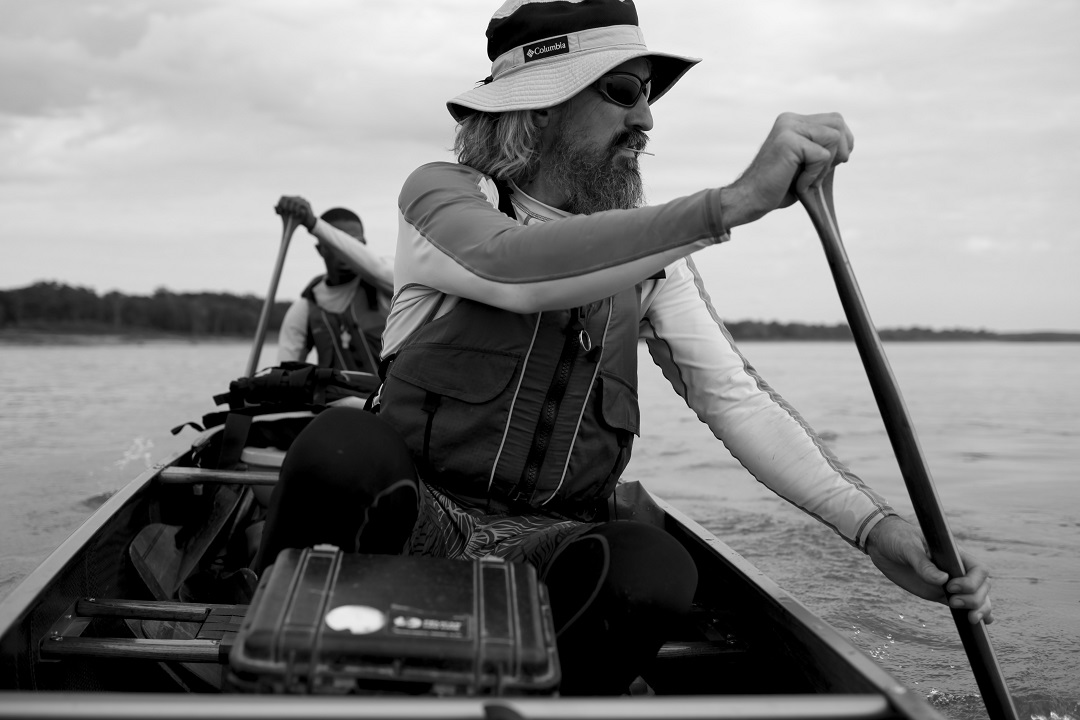John Ruskey is, by any estimation, a modern-day Renaissance Man. He’s an artist, musician, writer, speaker, educator, entrepreneur, and conservationist.
The man himself would claim he’s a frontiersman, one in the spirit of Meriwether Lewis and John Muir. More modestly, he’d say, “I’m just a river rat, a worker bee in the service of my queen, the Mississippi River.”
Born in the Front Range of the Rocky Mountains of Colorado, Ruskey first came to know the Mississippi in 1982. Upon graduating high school, he and a friend built a raft and floated its entirety, top to bottom, spending five months on a 12- by 24-foot raft. No experience, no local knowledge, and virtually no preparation.
Somehow, they survived. “It was a soulful experience — slow, powerful, deep, and expansive,” he recalled, almost 40 years later. And, like that, he was hooked.
Fast forward 16 years, to when Ruskey found his calling. Having been the curator of the Delta Blues Museum in Clarksdale, Mississippi, for six years — “The best indoor job I’d ever have” — Ruskey knew it was time for a change. “I was going nutty being indoors, getting claustrophobic,” he said.
Feeling the call of the river, he left the museum in 1998 and started the Quapaw Canoe Company, dedicated to creating unique expeditions allowing paddlers to experience the wildness and majesty of the Lower Mississippi. Now, 20-plus years on, the company continues that same mission while also hand-crafting wooden canoes and teaching others to do so through its skills-based apprentice program.

An outing with Quapaw Canoe Company.
The Rise of Rivergator
If Ruskey is a modern-day Renaissance Man, the Rivergator website is his manifesto.
Launched in 2012, Rivergator.org is an all-encompassing resource providing detailed descriptions and instructions for paddling the 1,154 miles of free-flowing river between St. Louis and the Gulf of Mexico. It’s an extensive collection of personal experience, info, and insight gleaned from more than 30 years of exploration. Canoeists, kayakers, stand-up paddleboarders — Rivergator is designed for anyone wishing to explore the Lower Mississippi by human-powered watercraft.
The site is one of a kind. There’s nothing comparable as far as depth of knowledge or amount of information. The homepage features an interactive map detailing the various sections of the Lower Mississippi, along with links to interviews and short videos starring Ruskey himself. There are details of the Quapaw crew’s recent exploits, along with links to safety recommendations and camping options.
While there’s a plethora of information on the homepage alone, the real “meat” of the website is found in the “Paddler’s Guide” and “River Log” tabs.
In the former, Ruskey covers everything from where the Mississippi River gets its name — it’s derived from the Native American Ojibwe name “misi-ziibi”, meaning “Great River” — to canoe and kayak river safety; from forecasting/monitoring river levels to how to paddle through a lock and dam.
“I want to actually teach the reader how to read the river,” said Ruskey. “Managing commercial traffic and navigating buoys, storm awareness and wind patterns — these are all vital skills when on the river.”
To this end, the site provides detailed information and practical instruction on the skills required to paddle such a large body of water.
While the “Paddler’s Guide” section could be called the skills section, the “River Log” is the information section. Here, Ruskey breaks down each individual leg of the Lower Mississippi in detail: water levels, unique obstacles, what to expect and how to navigate each portion — from St. Louis all the way to Baton Rouge — complete with side trips and alternative routes along the way.
“Paddling the Lower Mississippi comes down to three crucial things: experience, good preparation, and the right vessel and gear,” Ruskey said. “With the right combination of those three things, paddling the river can be safe and enjoyable.”

Watercolor map painting by John Ruskey.
Put Ins and Preservation
We asked Ruskey for some good spots for experienced, prepared, and well-equipped St. Louis-based paddlers to put in for a trip south on the Lower Mississippi. He suggests visiting him in Clarksdale.
“If you’re up for a road trip, Clarksdale is a great base for a two- to three-day adventure on the wildest stretch of the river, deep in the heart of the Mississippi/Arkansas Delta, where the river joyfully meanders between big islands, big forests, big beaches and big sky.”
Clarksdale is just a 350-mile (about 5.5-hour) drive south through Memphis.
“Chester [Illinois] and Cape Girardeau are great put-in spots as well,” said Ruskey. “The river is wild and beautiful along that stretch, and very easy to access.”
Both are within two hours of St. Louis.
Rivergator’s primary goal is to provide a means for more people to establish a connection with the Lower Mississippi.
“People that have a connection with a place have motivation to protect it,” Ruskey said.
And, from his perspective, it’s a place well worth preserving. Take it from a man with a life-long love affair with the Lower Mississippi. “The river flows through us. It’s part of us. It defines us. It’s the circulatory system of our nation, and we are responsible for protecting its wild and untamed beauty.”
John Ruskey, the Rivergator — artist, musician, writer, speaker, educator, entrepreneur, conservationist, and, as it turns out, poet, too.
Author: Nick Tilley is a regular contributor to Terrain Magazine.
Featured Image: Rivergator John Ruskey by Mathieu Despiau.


Sorry I missed the trip to Buck Island. Please update me on any late Nov. or early Dec. river trips. Thanks, Lloyd Baker ferrys51@hotmail.com.